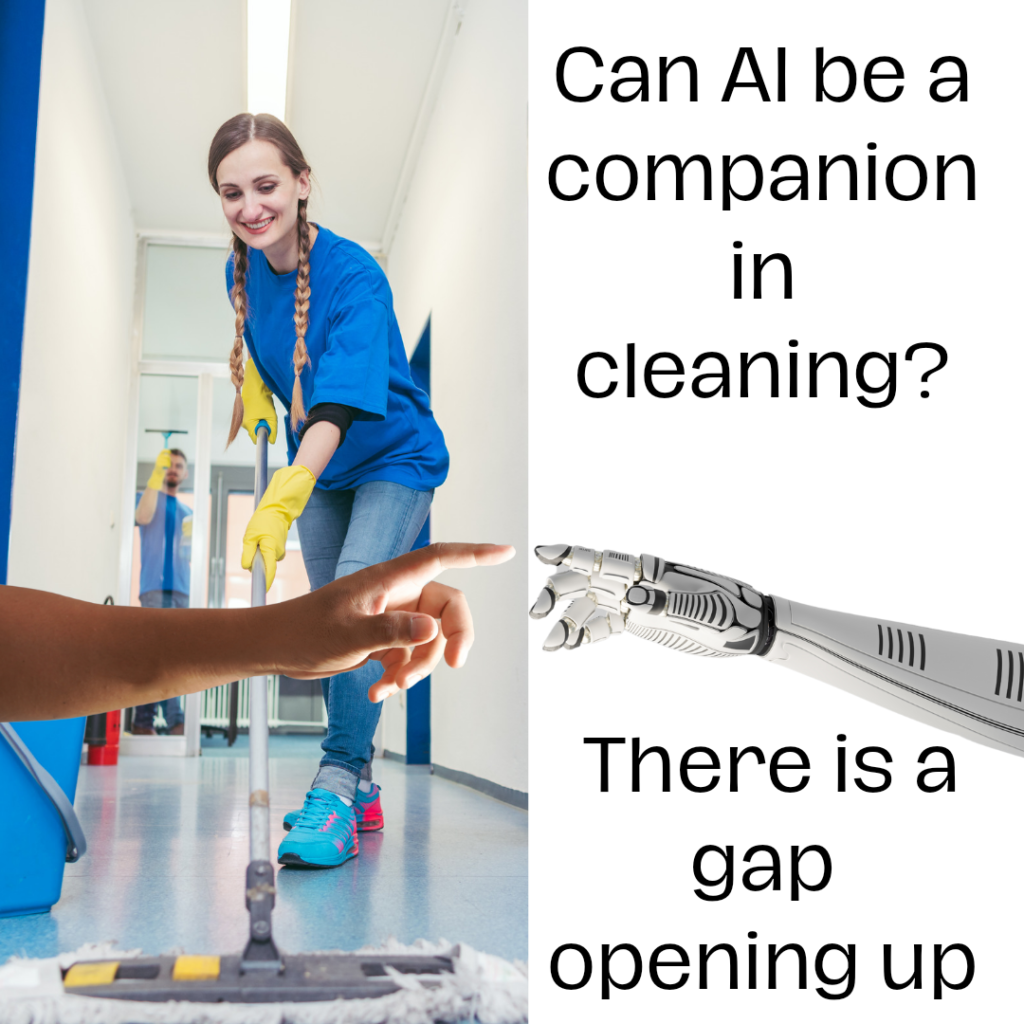Have you ever found yourself thinking of how to introduce AI into your cleaning process? Or the influence of Robitics in the cleaning sector? Well read further.
Robotics and AI are poised to revolutionize the cleaning sector by automating and enhancing various aspects of the process. Robotic cleaners equipped with AI can navigate spaces intelligently, identify and adapt to different surfaces, and optimize cleaning patterns. AI algorithms can analyze data to improve efficiency, scheduling, and resource allocation in cleaning operations. Overall, this integration can lead to more effective and autonomous cleaning solutions, reducing manual labor and enhancing productivity in the cleaning sector. Here are some examples:
- Autonomous Vacuum Cleaners: Robotic vacuum cleaners, equipped with sensors and AI algorithms, can navigate homes or commercial spaces, avoiding obstacles, and adapting their cleaning patterns based to suit the layout of the area and manner of use. The AI part helps the device to learn dynamically without human input. This can save a lot of human hours as vacuuming and sweep often account for a large proportion of cleaning time.
- Smart Floor Scrubbers: AI-powered floor scrubbers can analyze floor conditions and adjust cleaning methods accordingly. They may incorporate computer vision to detect stains or areas that require more attention, optimizing the cleaning process. Some upcoming technology feature high level sensors that monitor stains and can direct the floor cleaner to the righ location at the right time. This is very useful because it has the potential to reduce accidents from spillages but also it helps to maintain a highly welcoming space for its users.
- Predictive Maintenance: AI can be used to predict when cleaning equipment needs maintenance or replacement by analysing usage patterns and performance data. This proactive approach minimises downtime and ensures optimal functionality.
- Automated Window Cleaners: Robotic devices designed for window cleaning can use AI to identify dirty areas and efficiently clean windows on tall buildings. This not only improves safety but also enhances the speed and precision of the cleaning process. It also means you do not have to wait till the cleaner arrive to have a clear see through window. You cannot but wonder how these automated devices will clean a seagull poop splash, maybe we will move on to the nect point!
- Intelligent Waste Sorting: AI-powered robots can be employed in waste management to identify and sort different types of waste, promoting recycling and reducing the environmental impact of cleaning activities. Waste is a highly crucial part of sustainability. Untill we learn to manage waste correctly, net zero will remain a far-fetched idea. These sorting technologies are already available but in big recycling centres. By scaling them to meet the use of shopping centres, large offices, waste can be sorted much more accurately from source.
- Dynamic Scheduling: AI algorithms can analyse historical data, foot traffic, and usage patterns to dynamically schedule cleaning tasks. This ensures that cleaning resources are deployed efficiently, focusing on high-traffic areas during peak times.
- IoT-enabled Sensors: Internet of Things (IoT) sensors can be integrated into cleaning equipment to collect real-time data on cleanliness levels. AI algorithms can then analyse this data to provide insights for optimizing cleaning strategies. This will massively save human auditing time so it can be used on implementing improvements.
These examples showcase how the combination of robotics and AI can transform traditional cleaning methods, making them more intelligent, adaptive, and efficient. You may have also wondered about the extensive benefits of AI and Robotics?
- Increased Efficiency: Robotics and AI enable automated and optimized cleaning processes, reducing the time required to complete tasks. This efficiency allows cleaning businesses to handle larger spaces or more clients without a proportional increase in manpower.
- Cost Savings: Automation might have a larger upfront investment but in the mid to longvterm, it will reduce the reliance on scarce manual labour, cutting down labour costs over time. Additionally, predictive maintenance and smart scheduling help prevent equipment breakdowns, minimising repair costs and downtime.
- Improved Cleaning Quality: AI-equipped devices can analyse and adapt to different cleaning scenarios, leading to more thorough and consistent cleaning results. This enhances the overall quality of the cleaning service, satisfying clients and potentially attracting new business.
- Reduced Risk to Human: Autonomous cleaning robots can be deployed in hazardous environments or areas that pose safety risks to human workers. This minimises the potential for accidents and injuries, improving overall workplace safety.
- 24/7 Operations: Robots and AI-powered systems can operate continuously without the need for breaks, allowing cleaning businesses to offer round-the-clock services. This flexibility can be particularly beneficial for commercial and public spaces with varied operating hours.
- Data-Driven Decision Making: AI analytics provide valuable insights into cleaning patterns, equipment performance, and customer preferences. Cleaning businesses can use this data to make informed decisions, refine their strategies, and tailor services to meet specific client needs.
- Competitive Advantage: Adopting advanced cleaning technologies can set a cleaning business apart from competitors. Clients may prefer services that utilise cutting-edge solutions, contributing to a competitive edge in the market.
- Environmental Impact: Efficient cleaning processes powered by AI can contribute to sustainability goals. Reduced resource consumption, optimized scheduling, and smart waste management positively impact the environmental footprint of cleaning operations.
In summary, integrating robotics and AI into the cleaning sector brings about operational enhancements, cost savings, and a competitive edge, ultimately leading to improved customer satisfaction and business growth. As itbbecomes harder to recruit to labour intensive jobs such as cleaning a space is definitely opening up for robotic, artificially intelligent companions.

